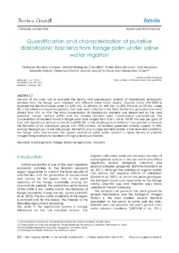Quantification and characterization of putative diazotrophic bacteria from forage palm under saline water irrigation.
Quantification and characterization of putative diazotrophic bacteria from forage palm under saline water irrigation.
Author(s): ANTUNES, G. dos R.; CARVALHO, B. R.; SULVA, T. R. da; NEIVA, J. N. M.; ARAUJO, G. G. L. de; FERNANDES JUNIOR, P. I.
Summary: The aim of this study was to evaluate the density and phenotypical diversity of diazotrophic endophytic bacteria from the forage palm irrigated with different saline water depths. Opuntia stricta (IPA-200016) received five depths of saline water (L1: 80%. ETo; L2: 60%.ETo; L3: 40%; ETo; L4: 20%; ETo and, L5: 0% ETo, where ETo is the reference evapotranspiration). The roots were collected in the field, disinfected, grounded and serial diluted from 10-1 to 10-4. The total concentration of diazotrophic bacteria was determined by the most probable number method (MPN) and the isolated bacteria were characterized phenotipically. The concentration of bacteria found in forage palm roots ranged from 0.36 x 104 to 09.89 104 cells per gram of root, with highest occurrence on the 60 and 80% ETo. In the dendrogram of similarity it was possible to observe the formation of 24 phenotypic groups with 100% similarity. All bacteria presented similarity superior to 40%. Among these groups, 14 are rare groups, formed by only a single bacterial isolate. In the Semi-Arid conditions, the forage palm that receives the highest amount of saline water, presents a higher density of putative nitrogen-fixing endophytic bacteria with high phenotypic diversity.
Publication year: 2017
Types of publication: Journal article
Unit: Embrapa Semi-arid Region
Observation
Some of Embrapa's publications are published as ePub files. To read them, use or download one of the following free software options to your computer or mobile device. Android: Google Play Books; IOS: iBooks; Windows and Linux: Calibre.
Access other publications
Access the Agricultural Research Database (BDPA) to consult Embrapa's full library collection and records.
Visit Embrapa Bookstore to purchase books and other publications sold by Embrapa.

